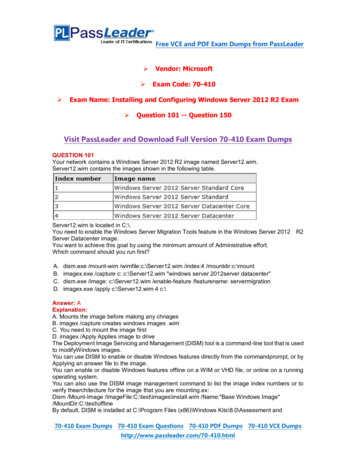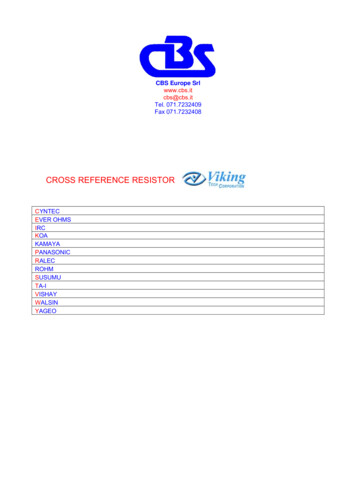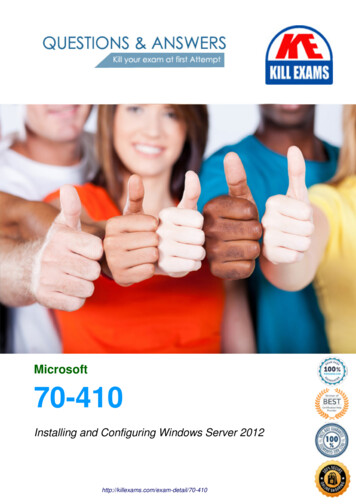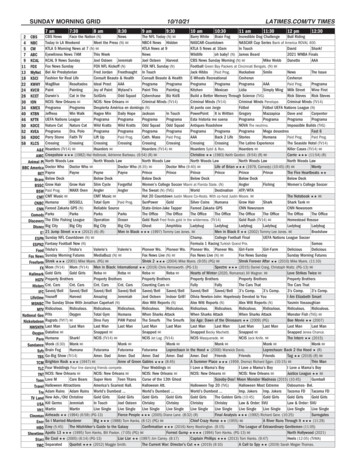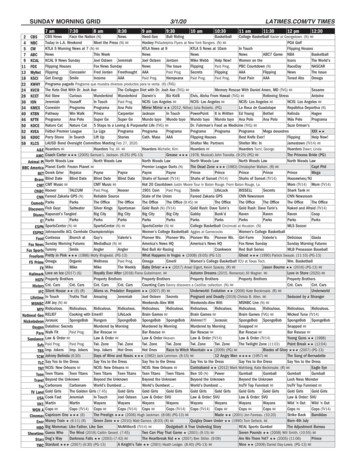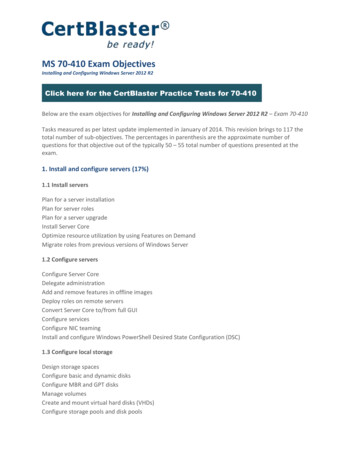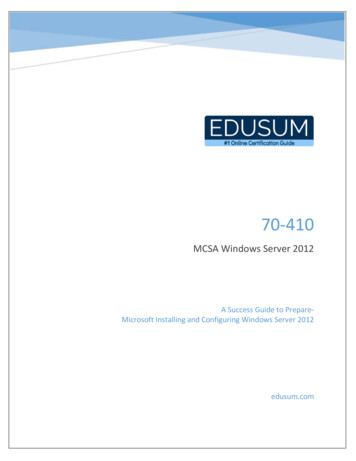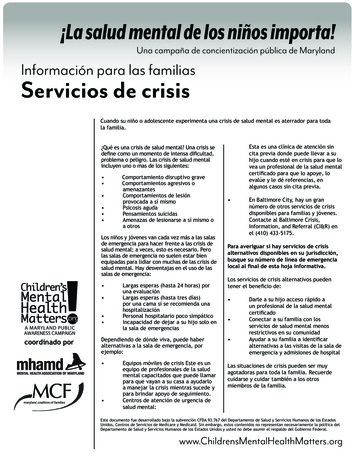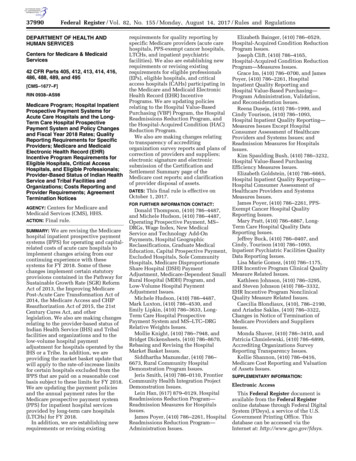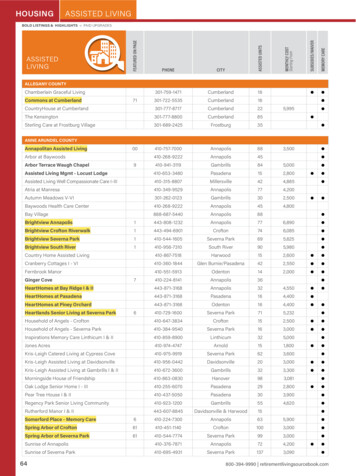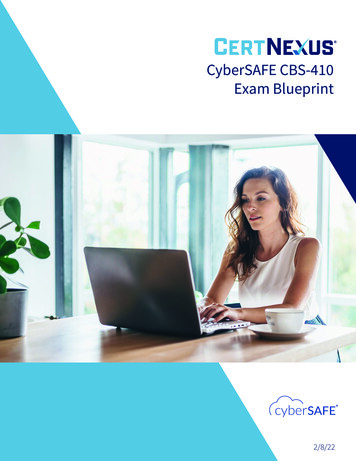
Transcription
CyberSAFE CBS-410Exam Blueprint2/8/22
Introduction to CertNexusCertNexus is a vendor-neutral certification body, providing emerging technology certifications andmicro-credentials for business, data, developer, IT, and security professionals. CertNexus’ mission isto assist closing the emerging tech global skills gap while providing individuals with a path towardsrewarding careers in Cybersecurity, Data Science, Data Ethics, Internet of Things, and ArtificialIntelligence (AI)/ Machine Learning.We rely on our Subject Matters Experts (SMEs) to provide their industry expertise and help us developthese credentials by participating in a Job Task Analysis, Exam Item Development, and determiningthe Cut Score. We also depend upon practitioners in the field to participate in a survey of the JobTask Analysis and beta testing to ensure that our certifications validate knowledge and skills relevantto the industry.AcknowledgementsCertNexus was honored to have the following Subject Matter Experts contribute to the developmentof this exam blueprint.Drs. Andor DemarteauShamrock Information Securitywww.ShamrockInfoSec.comGreg ChildersDevo Technologywww.devo.comMohamed HamdyRakictwww.rakict.comClaudia Laura Limón Lunaetc ibero americawww.etciberoamerica.comShinesa CambricMicrosoftwww.microsoft.comBenjamin FranklinBlue Screen ITbluescreenit.co.ukSteve ZimmerCopyright 2022 by CertNexus Inc. All rights reserved.CertNexus CyberSAFE CBS-410 Exam Objectives aresubject to change without notice.CertNexus CyberSAFE CBS-410 Exam Blueprint
CertNexus CyberSAFE CBS-410 ExamExam InformationA single click can lead to a multi-million dollar breach in seconds, and the employee responsiblemay not even be aware of their mistake. Many end users aren’t aware of the dangers accompanyingtoday’s most common cybersecurity threats, much less how to detect them. CyberSAFE helps ensurethat your end users can identify the common risks associated with using conventional end-usertechnology, as well as how to safely protect themselves and their organizations from security risks inoffice or while working remotely.Candidate EligibilityThe CyberSAFE (CBS-410) credential requires no fee, supporting documentation, or other eligibilityverification measures for you to complete the credential process. Simply purchase an access key forthe CyberSAFE (CBS-410) course from the CertNexus Store here. This course includes access to thecredential process directly through the CHOICE platform.Exam PrerequisitesWhile there are no formal prerequisites to complete the CyberSAFE credential process, it isrecommended that you have experience with the basic use of digital technology, such as desktop,laptop, and tablet computers; mobile devices; and basic Internet functions like web browsing andemail, whether you are working onsite or from a remote location.Once you have obtained this level of skill and knowledge, or if you already possess it, CertNexusalso strongly recommends that you prepare for the CyberSAFE credential by taking the CertNexus’CyberSAFE CBS-410 course.Exam SpecificationsPassing Score: 80% or 20/25 ItemsDuration: Estimated 20-45 minutes, candidates may retake as many times as desired.Exam Options: Online through the CHOICE platform or via eLearning.Item Formats: Multiple Choice/Multiple ResponseExam DescriptionTarget Candidate:This credential is designed for all users of computers, mobile devices, networks, IT services and theInternet to ensure they can use technology safely to minimize security risks while protectingorganizational assets.Exam Objective Statement:The assessment will certify that the successful candidate has the knowledge, skills, and abilitiesCopyright 2022 by CertNexus Inc. All rights reserved.CertNexus CyberSAFE CBS-410 Exam Objectives aresubject to change without notice.CertNexus CyberSAFE CBS-410 Exam Blueprint
required to identify the common risks associated with using digital technology and safely protectthemselves and their organizations from security risks.To ensure that candidates possess the aforementioned knowledge, skills, and abilities, theCyberSAFE CBS-410 credential will test them on the following domains with the following weightings:Domain1.0 Compliance2.0 Social Engineering3.0 Device and Data Protection4.0 Online Security and Remote AccessTotal% of Examination16%32%24%28%100%The information that follows is meant to help you prepare for your CertNexus credentialassessment. This information does not represent an exhaustive list of all the concepts andskills that you may be tested on during the assessment. The domains, identified previously andincluded in the objectives listing, represent the large content areas covered on the test. Theobjectives within those domains represent the specific tasks associated with the safe use ofcomputing devices you will be tested on. The information beyond the domains and objectives ismeant to provide examples of the types of concepts, tools, skills, and abilities that relate to thecorresponding domains and objectives. These examples do not necessarily correlateone-to-one with the content covered in your training program or on your test. CertNexusstrongly recommends that you independently study to familiarize yourself with any conceptidentified here with which you are unfamiliar before taking the assessment.Copyright 2022 by CertNexus Inc. All rights reserved.CertNexus CyberSAFE CBS-410 Exam Objectives aresubject to change without notice.CertNexus CyberSAFE CBS-410 Exam Blueprint
ObjectivesDomain 1.0Objective 1.1Objective 1.2Objective 1.3Objective 1.4ComplianceIdentify organizational security compliance requirements. Types of organizational compliance requirements Password policy Internet usage policy Data protection Personally Identifiable Information (PII) Personal Health Information (PHI) Acceptable Use Policy (AUP) On site vs. remote Equipment Shared resources (passwords, mailboxes, etc.) Job function differentiation Facility policies Employee/visitor access Badge requirements Key policies Ramifications of non-complianceIdentify legal compliance requirements. Types of legal compliance requirements Regulation/law HIPAA SOX GDPR NISD e-privacy directive Legal consequences of non-complianceIdentify industry compliance requirements. Examples of industry compliance requirements PCI DSS ISO 27001 NISTIdentify security and compliance resources. Organizational compliance resources Handbooks/websites AUP documentation Updates Location/access Departments Human Resources Information Technology Information Security Incident reporting Legal compliance resourcesCopyright 2022 by CertNexus Inc. All rights reserved.CertNexus CyberSAFE CBS-410 Exam Objectives aresubject to change without notice.CertNexus CyberSAFE CBS-410 Exam Blueprint
Domain 2.0Objective 2.1Objective 2.2 Government websites Legal departments Insurance providers Industrial compliance resources Industry associations/professional groupsSocial EngineeringRecognize social engineering attacks. Attack vectors (points of entry) Username/password Organizational/personnel information Physical access End-user personal information Email Mobile device Attack goals Data destruction Data theft Financial gain Financial harm Political gain Reputation Revenge High-value targets C-suite Accounting personnel HR personnel IT personnel Attack types Phishing Whaling Spear fishing Vishing Smishing Pharming Baiting Pretexting Impersonation (CEO Fraud) Quid pro quo Tailgating/piggybacking Shoulder surfingDefend against social engineering attacks. Resources to defend Organizational hardware/devices Organizational data Network access Premises accessCopyright 2022 by CertNexus Inc. All rights reserved.CertNexus CyberSAFE CBS-410 Exam Objectives aresubject to change without notice.CertNexus CyberSAFE CBS-410 Exam Blueprint
Domain 3.0Objective 3.1Objective 3.2 User credentials Mitigation techniques Situational awareness Badging systems/security checks Door locks Verification of requests Proper disposal/deletion of sensitive information Continual education/training Communication Compliance auditDevice and Data ProtectionMaintain the physical security of devices. Organizational and personal devices containing potentially sensitive data Laptops/computers Mobile phones Tablets Removable storage Organizational device-security requirements Limiting the devices that have access to sensitive data Credentials Acceptable devices for data storage Disposal/deletion requirements Digital presence Device logs Temporary files Browser history Cached/saved credentials IoT devices Cloud storage Device physical security techniques Proper storage/disposal/recycling Loss/theft reporting Locking unattended machines/devices BYOD controls Remote wipe functionality Location detectionUse Secure Authentication Methods. Something you know Passwords/PINs Frequent changing Complexity Prohibiting reuse/sharing Memorization vs. recording/documenting Something you are Biometrics Finger printCopyright 2022 by CertNexus Inc. All rights reserved.CertNexus CyberSAFE CBS-410 Exam Objectives aresubject to change without notice.CertNexus CyberSAFE CBS-410 Exam Blueprint
Objective 3.3Objective 3.4 Facial recognition Retinal/iris scan Something you have Authentication apps Key fob Tokens Smart cards Authentication best practices Password managers Covert entry (ensure nobody can watch you enter it) Immediately change following breach/incident Secure storage of passwords Critical importance of protecting email passwords Multi-Factor authentication use when possible Complexity compared to sensitivity of data Unique passwords for all sites and systems Avoiding using easy-to-guess passwords PassphrasesAdhere to data and sensitive data protection best practices. Data backups/storage locations Mobile device considerations Information leakage through always-on app functionality Accidental or intentional recording of sensitive data Camera Microphone Data security techniques Alerts for access/ deletion of data Data classification Prohibitions against copying/printing Proper disposal of printed data Prohibitions against removable storage devices Prohibition against mobile devices in designated locations Digital presence considerations Device logs Temporary files Browser History Cached/ saved credentials IoT devices Cloud StorageIdentify potential sources of malware and prevent infection. Malware effects System corruption Spying/logging Distracting/annoying Device performance degradation Data hijacking/ransomingCopyright 2022 by CertNexus Inc. All rights reserved.CertNexus CyberSAFE CBS-410 Exam Objectives aresubject to change without notice.CertNexus CyberSAFE CBS-410 Exam Blueprint
Data destruction Blackmail Advertising Malware types Key logger Ransomware Adware/spyware Trojan horse Virus Worm Browser hijacker Malware sources Trick offers Rogue antivirus Free software scams Software piggybacking Confusing or obscured options (custom installations) Unknown/untrusted download sites Open Networks Email attachments Links Scripts in data files/software Advertising banners Infected hardware Thumb drives External hard drives Malware prevention techniques Careful reading of emails/dialog boxes/offers/pop-ups/etc. Malware prevention software IT approval for software installation Inspection of links before selecting Benefit/risk analysis when installing software General system behavior awareness Use of only known vendors and devices Verified publishersObjective 3.5Use wireless devices securely. Common wireless network risks Eavesdropping Unsecure networks Private Public Open Rogue access points Evil twins “Remembering” wireless networks Secure wireless device use techniquesCopyright 2022 by CertNexus Inc. All rights reserved.CertNexus CyberSAFE CBS-410 Exam Objectives aresubject to change without notice.CertNexus CyberSAFE CBS-410 Exam Blueprint
Public network use prohibitionsEncryption WPA2/WPA3 Securing Wi-Fi passwords Wireless network “forgetting” Evil twin avoidance Misspelled network names Lack of password requirements when they are expected Multiple networks with similar namesDomain 4.0Objective 4.1Objective 4.2Online Security and Remote AccessBrowse the web safely. Well-known browsers Chrome Edge Firefox Safari URL construction HTTP vs. HTTPS Non-encryption vs. encryption Top level domains Domain names Suspicious/spoofed URLs Close spellings/misspellings Safe web browsing techniques Current and updated web browser use Deciphering web addresses Shortened (Bitly) Misspelled Wrong top-level domain (.com v .net) Redirect (changed URL) Unknown add-in, plug-in, toolbar avoidance Not clicking/tapping ads and pop-ups Protocol verification URL verification when using links Typing vs. clicking Bookmarking common sites Caution when using mobile devices (URLs not always visible)Use email securely. Common email use risks Frequent social engineering attacks Security concern alerts Requests for user credentials Malware removal/IT support offers Free offers Monetary/inheritance scamsCopyright 2022 by CertNexus Inc. All rights reserved.CertNexus CyberSAFE CBS-410 Exam Objectives aresubject to change without notice.CertNexus CyberSAFE CBS-410 Exam Blueprint
Objective 4.3 Requests for information Fake invoices from debt collectors Fake credit card expiry notifications Urgent requests form supervisor/ executive level Malicious attachments High-risk file types ZIP/ Compressed files .exe JavaScript Attachment policy/regulation compliance Safe email use techniques Imposter identification Sender name vs. email address Subject line topics Tone/voice/grammar of sender Signature lines Unusual/atypical/urgency requests from seemingly valid sources “Bank” asking for password in email “IT” asking for personal info via email Sender verification Call back/meet in person before responding/clicking Email use policy compliance Attachment considerations Approved third-party cloud storage (Dropbox, Box, etc.) Password protected EncryptedUse social networks securely. Social network security considerations Accidental sharing of sensitive information Combined sources of data (multiple platforms, posts, replies, likes, etc.) Disparaging/revealing comments Representing yourself vs. the organization Sensitive information Lack of control over data and sharing Confidentiality Once posted, always online Consent to data sharing Ambiguous/lengthy confusing security settings Opportunities for social engineering Spoofed accounts Hacked accounts Strong authentication Password Multi-Factor Authentication (MFA) Safe social networking techniques Alignment with organizational social networking usage and policiesCopyright 2022 by CertNexus Inc. All rights reserved.CertNexus CyberSAFE CBS-410 Exam Objectives aresubject to change without notice.CertNexus CyberSAFE CBS-410 Exam Blueprint
Objective 4.4Objective 4.5 Thorough research and configuration of security and privacy settings Caution with sharing any potentially sensitive or reputation-damagingiiiiiiinformation Security of credentials Social engineering awareness Verify connections Verification of content Fact checkingUse cloud services securely. Cloud service risks Cloud service spoofing Vendor changes Acquisitions/mergers Out of business Mixing up work and private accounts (digital storage location) Compromising credentials Data persistence IoT device considerations Data collection Safe cloud service use techniques Organizational approval for all cloud-based storage Local backups Extra credential vigilance Secure network connectionWorking from remote locations securely. Connecting securely VPN Scanning for vulnerabilities (Health check) Anti-Virus Software Home Network Security Password sharing Updated router firmware Separate professional and personal Separate network Devices Data Cloud storage Remote Management / Managed device Smart Home Devices Access point for network entry Shut down smart home devices Collaboration platforms Personal accounts vs. corporate accounts Background Recording AuthenticationCopyright 2022 by CertNexus Inc. All rights reserved.CertNexus CyberSAFE CBS-410 Exam Objectives aresubject to change without notice.CertNexus CyberSAFE CBS-410 Exam Blueprint
Access to microphone/ videoSharing settingsContinuing Education RequirementsThe CyberSAFE CBS-410 credential is valid for 1 year from the time the certificate is granted. You musttake the Recertification Credential for CyberSAFE or take the most up-to-date version of theCyberSAFE credential prior to the 1-year period’s end to maintain a continuously valid certification.Copyright 2022 by CertNexus Inc. All rights reserved.CertNexus CyberSAFE CBS-410 Exam Objectives aresubject to change without notice.CertNexus CyberSAFE CBS-410 Exam Blueprint
CertNexus offers personnel certifications and micro credentialsin a variety of emerging technology skills including Cybersecurity,Cyber Secure Coding, the Internet of Things (IoT), IoT Security, DataScience, Artificial Intelligence, and Data Ethics. For a complete list ofour credentials visit https://certnexus.com/certification/.3535 Winton Pl, Rochester, NY 146231-800-326-8724 info@certnexus.comcertnexus.com
CyberSAFE CBS-410 credential will test them on the following domains with the following weightings: Domain % of Examination 1.0 Compliance 16% 2.0 Social Engineering 32% 3.0 Device and Data Protection 24% 4.0 Online Security and Remote Access 28% Total 100% The information that follows is meant to help you prepare for your CertNexus credential .

